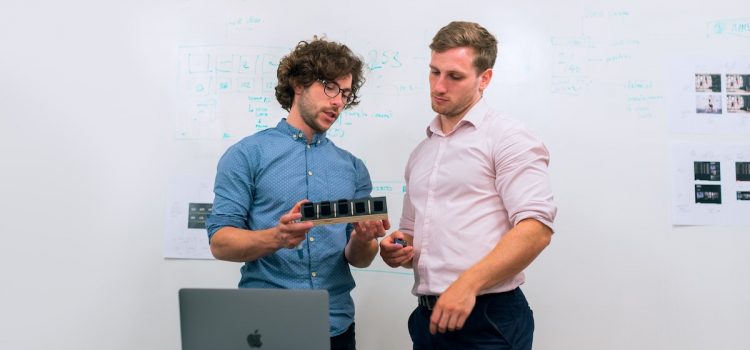

This article gives you a glimpse of what you can learn with Shortform. Shortform has the world’s best guides to 1000+ nonfiction books, plus other resources to help you accelerate your learning.
Want to learn faster and get smarter? Sign up for a free trial here .
Do you want to stand out against competitors in the market? How much customer feedback is enough to test your product?
The product development process can be a rough journey. It’s not as simple as coming up with a brilliant idea and selling it immediately. To take action, you need to follow four steps that include every detail that goes into creating a product that will sell.
Let’s look at the four stages of product development that can set up your product for success.
Stage 1: Coming Up With an Idea
Many companies’ first stage of product development is starting with an idea. So where do ideas come from? The $100 Startup by Chris Guillebeau says that the purpose of a product is to make people’s lives better or easier. This means that the first thing you need to do is find your target audience, which will spark ideas for a new product that will change their lives.
To be successful at the first product development stage, break your ideal customers down into demographics. There are two kinds of demographics:
- Traditional demographics, which include age, sex/gender, income, race/ethnicity, and location
- New demographics, which include shared beliefs, skills, interests, passions, and values
While traditional demographics can be useful for specific organizations, new demographics are usually more effective as they pinpoint the wants and needs of your target audience.
When thinking about products your target audience would use, consider the following strategies:
- Jump onto a popular trend that appeals to your target audience. These often pop up in the areas of dieting, fitness, technology, social media, and entertainment. For example, you could coach people interested in fitness through a trendy diet plan such as Whole30 or Paleo by giving personalized meal plans and grocery lists.
- Ask your audience. Using surveys and interviews, ask people within your target demographic what they’re looking for in a product. One of the most straightforward ways to get people interested in your business is to sell them a product they already want. Once you have an idea about the products you’re looking to offer, reach out and ask for feedback on your ideas.
Brainstorming
Now that you know what your target audience is interested in, you can start brainstorming product ideas. According to Getting Things Done by David Allen, brainstorming follows these three rules:
1. Don’t criticize, judge, or challenge ideas. You can be most creative when you’re not self-censoring or restricting yourself by thinking about what could be wrong with one idea or another. In a group setting, create an open and inclusive atmosphere where people feel comfortable to throw ideas out and see what sticks.
People can still point out what might be problematic with an idea, but they should frame their thoughts in a way that leads to follow-up ideas rather than simply shutting down an idea or train of thought.
2. Aim for quantity over quality. Cast a wide net for ideas. The more ideas you put out there, the better your odds of having some great ones in the pile.
3. Analyze and organize later. Trying to analyze and organize your ideas as you come up with them will stifle your creativity. Let loose now, knowing that you’ll organize your thoughts in the next step of the process.
You can brainstorm small projects in your head, but writing down your ideas is useful for the same reason it helps to capture all your tasks in an external place: It gets them out of your head. When you’re brainstorming, writing down your ideas frees up your mind to keep thinking creatively and come up with even more ideas.
Since brainstorming produces ideas big and small, in random order, there are a few techniques you can use to capture your ideas that are less structured and linear than a list, including:
- Mind mapping: a visual tool that helps structure relevant information around a central idea.
- Fish bone diagram: a tool in the shape of a fish bone that identifies possible causes for an effect.
- Webbing: a common writing or research tool that’s a flexible map for organizing information around a central concept.
Stage 2: Designing the Product
After you have a good idea of what you’re creating, it’s time to move on to the next stage of product development: designing. The Design of Everyday Things by Don Norman says you should design with the user in mind.
As technology evolves, new fields of design pop up to focus on specific problems. User interaction is important in every subfield, but it’s most often talked about in industrial, interaction, and experience design.
- Industrial design focuses on the creation and development of physical objects, with a particular focus on function, aesthetics, and value.
- Interaction design focuses on the interface between the user and the object, usually in a digital context (think website design).
- Experience design focuses on the emotional experience of using a product, service, or environment.
Each of these fields focuses on redefining “good” design in terms of user experience. Two important principles guiding this definition are discoverability and understanding.
Discoverability refers to whether a user can figure out what an object is and how to use it without considerable effort. Discoverability answers the question, “How do I use this thing?” For example, the style of a door handle and the location of the hinges make it easy to discern what that object is and how it works—it’s easily discoverable. But a modern or industrial door with no visible hardware can be almost impossible to figure out.
Understanding, in this stage of product development, refers to the user’s ability to make meaning out of the discoverable features of the object. Understanding answers the questions, “What is this, and why do I want to use it in the first place?” On a normal door, handles and hardware indicate where to push or pull—but they also help us understand what this object is (a door) and what it’s used for (opening and closing). In other words, good design has to consider, not only the form and function of a product, but also the experience of interacting with that product.
How to Make a Useful Design
Sprint by Jake Knapp, John Zeratsky, and Braden Kowitz offers six steps for drawing designs for your new product in this stage of product development.
Step 1: Gather inspiration from other product features. The authors argue that every good idea builds off of what came before, so you’ll start by gathering inspiration from other products and services. Every team member should make a list of products, either from your company or from another, that have features you can emulate in your own product. In short presentations, each person will explain the contents of their lists. As people present, record every product mentioned with a little sketch and blurb explaining what inspiration it has to offer.
Step 2: Draw your ideas. Once you’ve reviewed your outside examples, it’s time to start drawing concrete designs for your product. Each team member should complete their drawings individually. You’ll refine your ideas as you go through each of the remaining steps.
Step 3: Review information and take notes. For 20 minutes, the authors suggest you silently review the information collected on the whiteboards. Write down any details from your flowchart, your goal, your questions, and the list of inspirational examples that may contribute to your product’s design. These notes will be a reference of what you’ve developed so far as a group, keeping you aligned with the team’s vision as you draw out ideas for the product.
Step 4: Put your thoughts on paper. Now, the authors say, it’s time to start generating ideas for your product design with some loose brainstorming. For another 20 minutes, write or draw any thoughts you have about the product in the form of diagrams, doodles, and text—as the thoughts come, put them on the page.
Step 5: Create 60-second design drawings. Now, the authors state, fold a sheet of paper into eight sections. In each section, take 60 seconds to draw a rough design of your product or a component of the product. It’s helpful to do multiple variations of the same idea. These should be more specific than anything you generated in Step 4, but they still don’t have to be polished. This step is meant to challenge you to quickly think of multiple design approaches to the same product.
Step 6: Finalize your best design idea. Create a final drawing of your idea on three sticky notes in the form of a storyboard. Each panel should show a step required to use the product or a different feature of your design. This should be the best product design you can come up with.
Stage 3: Creating and Testing the Prototype
You’ve designed your product—now it’s time to actually build it. But your first creation is never the one you put out on the shelves. It’s the prototype that you need to test to ensure it delivers expectations. According to Sprint, your prototype that you create in the third product development stage should be sophisticated enough to create the illusion of a complete product but not so complicated that you can’t finish it. You can go back and add missing pieces later. All you have to do is create the features that will give you the information you need from the customers.
For example, instead of trying to build a recommendation tool that features every book in their inventory, the bookstore could create a tool that pulls recommendations from a list that has one or two books per genre. The customer would still receive a recommendation based on their choices, but the team wouldn’t have to waste time inputting every title they have in stock.
Before you begin building, divide the responsibilities for the creation of the prototype. Knapp, Zeratsky, and Kowitz recommend filling the following roles.
- One or two people make the individual components of the prototype. The authors suggest designers and engineers for this role.
- One person links the component parts into one cohesive product.
- One person writes any text necessary for the prototype.
- One person gathers any media (sounds, images, sample content, and so on) that can be borrowed for your prototype.
- One person writes the customer interview script and conducts the interviews. To be as unbiased as possible during the interview process, the interviewer shouldn’t work on the prototype itself.
- Have the person who linked all the pieces of the prototype together present a full run of its use to the team. If any components of the prototype don’t match up with the storyboard, you still have some time to fix them before you go home for the day.
The Testing Phase
According to the authors, an essential part of the third stage of product development is testing out your product and receiving feedback from customers. You can identify the majority of problems with a product through just five customer interviews. This means they can all be done on the same day. Each interview will be an hour long with a half-hour break in between. The person acting as the interviewer will be in one room with the customers and the prototype.
You’ll need to set up a webcam with video and sound that captures the customers’ reactions, as the rest of the team will be watching the interviews live in the other room. (Confirm that the customer is comfortable being recorded, and have them sign any necessary legal documents before you proceed.)
Engage the customer in small talk to build rapport before gradually beginning to ask questions that tell you how the customer might use your product in their everyday life. For example, the interviewer for the bookstore team might begin by asking a customer about their job or their hobbies and interests. Then, they could start to ask about the customer’s reading habits and experiences with book buying. How do they typically choose their next read? How often do they speak to bookstore employees? Have they ever used an online recommendation service to find books before?
Next, the interviewer should introduce the prototype and encourage the customer to begin using it. Knapp, Zeratsky, and Kowitz advise that you don’t tell the customer exactly how to use the prototype—leave them to figure it out for themselves. This will help you see if the product is naturally easy to use or if it has unexpected problems.
As they use the prototype, you can also ask the customer questions about their opinion of different product features, what they think will happen next in the sequence, and what they imagine the purpose of different features will be. After the customer has tested the prototype, have a short discussion with them about what worked, what didn’t, and what they’d change. This is your chance to understand their overall impressions.
The rest of the team should watch the interviews together in the other room. To prepare, draw a grid on a whiteboard with a column for every interviewee and a row for each important component of the prototype. Silently write down quotes from the customers that seem like significant observations and interesting customer reactions on sticky notes. Label them positive, neutral, or negative. As you write your sticky notes, place them in the appropriate boxes on the grid based on the component they refer to.
The authors instruct you to silently review the notes on the whiteboard after the interviews, looking for patterns in the feedback. Did several customers comment positively on the same feature? Did several customers struggle during the same step? You can use these patterns to identify places that need improvement or features that worked particularly well.
Then, assess your findings by looking back at your sprint questions and your goal. Did you learn what you were hoping to? If not, what are your next steps? Even if your prototype was a success, the sprint probably still revealed flaws you need to address. Now you have the information you need to do that efficiently and effectively. If you still have questions you want to answer about your product, or you’re not sure where to take it next, you can always run another prototype. Whatever your results, no prototype is ever a waste of time.
Stage 4: Introducing the Product to the Market
You’ve used customer feedback to perfect your product, and now you’re ready to sell. The final stage of product development is to secure a distribution channel that can actually sell your product to your target customer. Noting that different types of distribution systems are better able to reach different types of customers, Geoffrey Moore’s book Crossing the Chasm advises that your choice of channel and your pricing are the most significant factors in the effectiveness of distribution.
For the purpose of distribution, he categorizes target customers according to their job titles and advises that these different customers are more easily reached by different sales channels:
- According to Moore, Engineers are best reached by a two-phase approach: First, you publish your product specifications online. Then you send sales personnel to meet with them and conduct demonstrations or facilitate testing once they express interest. This works because engineers don’t respond well to promotional marketing and typically don’t have corporate purchasing authority but can put you in touch with their purchasing department when you demonstrate your product.
- Moore recommends reaching out to Enterprise Executives by sending your senior staff to leadership conferences where they can connect with them and develop a consultant-like relationship. He calls this “relationship marketing.”
- Moore advises cultivating relationships with Department Managers through an online system that provides basic information about your product and then connects them with a human sales representative who is also online. Managing customer relationships digitally is more efficient, which is important because department managers typically place smaller orders than enterprise executives.
- If your target customer is a Small Business Owner-Operator, Moore recommends distributing your product through a value-added reseller (VAR). VARs can provide local service and support as well as help the customer set up the product and educate them on how to use it, all of which small business owners tend to find particularly helpful.
- For selling to End Users, Moore recommends fully automated online self-service, with FAQ and community help forums to streamline support. This is necessary because end users typically make relatively small purchases, and so you can’t afford to spend time dealing personally with each customer.
Price Your Product to Sell
Once you’ve selected a distribution channel that can reach your target customers effectively, the final element in this product development stage is to set your product’s price such that it motivates the distributor to sell your product.
When you’re selling a product with a disruptive innovation, salespeople may initially have to put in some extra work to close sales. Thus, Moore advises building enough profit margin into your product’s retail price that it’s worthwhile for your distributor to go out of their way to sell it.
He also cautions you not to set your price too high or too low. He says your price is too high if it becomes a sticking point with prospective customers. However, he also asserts that early-majority customers (a group of people who purchase products when prototypes have been tested successfully) expect the market leader to charge up to 30% more than their competitors because the leading product should give the customer a competitive edge and keep whole-product costs down. Thus, if you’re trying to position yourself as the market leader, your pricing should be consistent with your positioning claim.
Final Words
You may have to repeat certain stages of product development to get the outcome you desire. It’s all a part of the process—nobody gets it perfect on their first try, and you certainly don’t want to put a product on the market that you’re not confident in.
Did you find this exploration of the stages of product development helpful? Let us know in the comments below!

Want to fast-track your learning? With Shortform, you’ll gain insights you won't find anywhere else .
Here's what you’ll get when you sign up for Shortform :
- Complicated ideas explained in simple and concise ways
- Smart analysis that connects what you’re reading to other key concepts
- Writing with zero fluff because we know how important your time is





